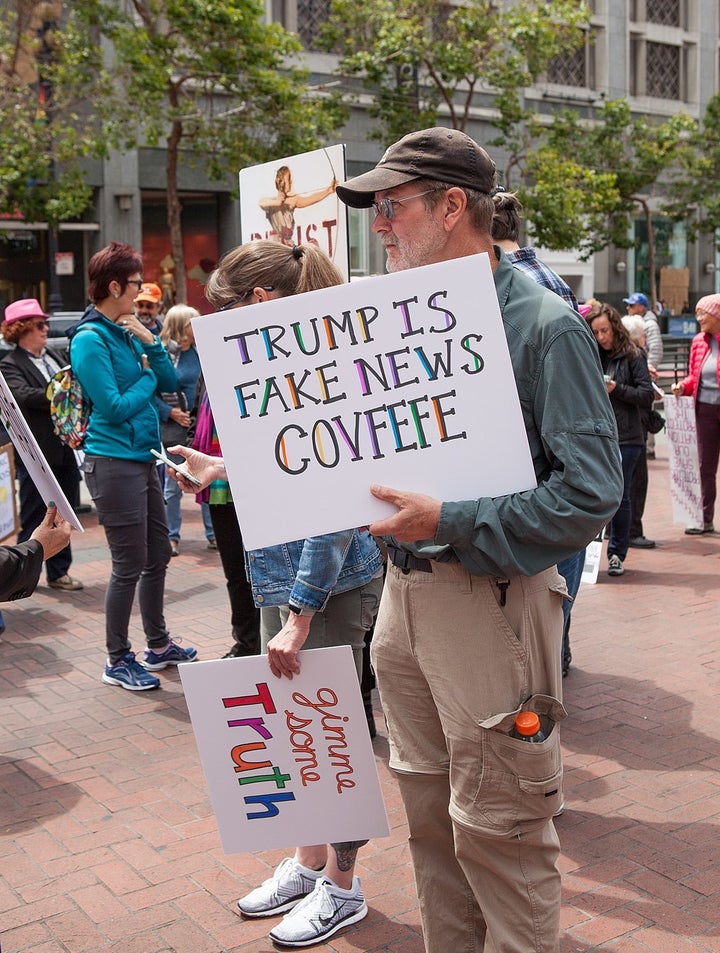The Collins English Dictionary named “fake news” as Word of the Year 2017. Collins defines fake news as “false, often sensational, information disseminated under the guise of news reporting”.
In August 1835, the New York Sun ran a six-part story that claimed that life on Moon had been discovered, including “a small kind of rein-deer, the elk, the moose, the horned bear, and the biped beaver” and human bats that were “doubtless innocent and happy creatures”. The Great Moon Hoax increased the newspaper’s circulation. So fake news is not new. It is at least as old as the tabloid press, for which it serves as a means for increasing its audience, sales, advertising rates and profits. Lies, scandalisation and tabloidisation are profit strategies.
What is new is the way fake news is organised: they have moved from traditional media to the networked online and social media environment, where fake news created in troll factories by low-paid fake news labour spreads through targeted advertisements, personal networks, fake profiles, bot-generated attention and likes.
Why is there so much fuss about fake news?
Between September and November 2016, at least 3,000 political ads that seem to have contained election-relevant fake news and targeted US citizens, were posted on Facebook. According to estimations, 126million US users had seen such content on Facebook alone. There is evidence that suggests that also on Twitter fake accounts tried to influence US election results. Google revealed that it is likely that between 2015 and summer 2017, fake accounts had uploaded more than 1,100 videos with a total of 43 hours of content to YouTube and had bought Google ads. According to a report, more than 400 fake Twitter accounts posted content about Brexit. During the 2017 French presidential election, 30,000 automated Facebook accounts spreading fake news were suspended and up to a quarter of the political links shared on Twitter contained fake news. The online software tool TwitterAudit estimates that 45% of Donald Trump’s 43million followers are fake accounts. A study says that during the third US presidential election television debate, political bots posted 36.1% of the pro-Trump tweets and 23.5% of the pro-Clinton tweets.

How online automation puts profits over democracy
In 2017, parliamentary inquiries of fake news took place, including a US Senate Judiciary Committee hearing and two inquiries by the House of Commons’ Digital, Culture, Media and Sport Committee (DCMSC). Twitter replied to a DCMSC request that it tackles fake news by using “automated systems” to “identify suspicious attempts”. It suggests that the automation of human activities on social media that is among the causes of the spread of fake news is also its cure. Social media corporations keep their wage costs low and increase their profits by letting algorithms take over vital activities, including checking the validity of content and profiles. The algorithm does not discern if an ad’s content is about detergent or a fake news story aimed at manipulating election results. It is blind to politics and morals because it is programmed to sell ads and generate attention. Dominant social media platforms are driven by the logic of algorithms, algorithmic automation, targeted advertising, and big data. By putting automation over humans, social media corporations put their profits over democracy. Given their profit interests, one cannot expect them to come up with real solutions without legal requirements.
What can be done against fake news?
Outlawing targeted and behavioural political online advertising would no longer allow social media to present targeted political ads to users accessing the Internet from IP addresses within the legislating country. Introducing such a measure is only effective if it is accompanied by penalties for violations of the political online ad ban. Such penalties can only be reasonably enforced if legislation does not define the advertising client, but the ad-selling online platform as the offender. Ad clients can be located anywhere in the world, which makes enforcing penalties from one country difficult. Therefore the ad-presenting platform should be legally liable. In order to be effective, the penalty fare should be set at a significant share of the offending online companies’ worldwide annual revenue. Given that fake news has become a global problem, it is likely that other countries will follow suit once one country starts outlawing targeted and behavioural political online advertising.
Substituting algorithmic activity by paid human work of fact-checkers and knowledge professionals can help reducing the dangers to democracy posed by fake news. Fact-checking does not work if it is simply crowdsourced, but rather requires adequate funding for sustaining full-time jobs of fact-checkers. It makes sense that large social media companies are by law required to either depending on their number of active monthly users directly hire a specific number of fact-checkers or to co-operate with and pay for the services of a specific number of employees of independent, non-profit fact-checking organisations. If social media platforms are by law required to introduce a fake news alert button that triggers a fact check when a specified number of users click the button in respect to a specific content item, then progress could be achieved.
Fake news culture can only be overcome if alternative forms of political online communication are actively fostered. This requires new types of online platforms and new formats that decelerate news and political communication and act as slow media. In Europe, there is a long tradition of public service media. There is no European equivalent of Twitter, YouTube and Facebook. Regulatory changes that allow public service broadcasters to offer online formats and social media platforms (such as Club 2.0 and other formats) aimed at advancing political communication and slow media that are advertising-free and adequately funding such activities form a good way of establishing an alternative culture of political communication that weakens fake news culture. Advancing public service Internet platforms is a step towards overcoming fake news culture.
Acknowledgement: This contribution is based on a submission that Christian Fuchs made to the DCMSC Inquiry of Fake News.